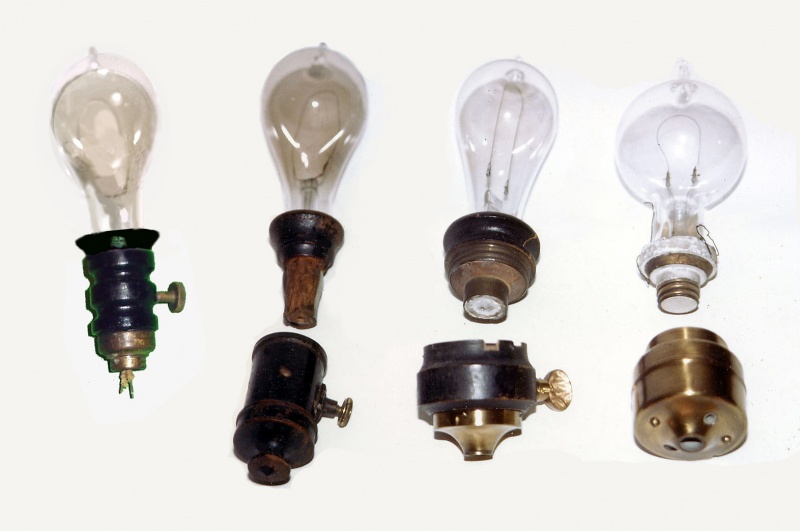File:1880EDISON1881LampsSOCKETSrwLIPACKowner.jpg

Original file (1,572 × 1,044 pixels, file size: 497 KB, MIME type: image/jpeg)
EVOLUTION OF EDISON'S INCANDESCENT ELECTRIC LIGHT BULB AND SOCKET - 1880-1881
From left to right: First form "1880 Wire Terminal Base" Edison socket and electric light bulb as used on Henry Villard's Oregon Railroad and Navigation Company's S.S. Columbia - the first installation anywhere of an Edison lighting system; Second form "1880 Wire Terminal Base" Edison socket and electric light bulb; "1880 Original Screw Base" Edison socket and electric light bulb and the "1881 Improved Screw Base" Edison socket and electric light bulb.
All Edison sockets and bulbs are from the former Mt. Vernon Museum of Incandescent Lighting, Baltimore, Maryland - which contained the landmark private collection of the early electric lighting of the late Dr. Hugh M. Hicks.
The first socket and incandescent light bulb shown above, i.e., comprising the first form "1880 Wire Terminal Base" as stated is identical to that installed on the S.S. Columbia. When this form of socket was installed onboard the ship for the initial trial the first week in May 1880, it was found that the intense vibration created by the two all 'long waist Maryann' Edison dynamos employed, caused the light bulb filaments attached to the first form "1880 Wire Terminal Base" socket, to break. This occurred because the socket had a threaded brass base that was screwed to a threaded mount attached to the wall of the ship's interior - all which transmitted the vibration of the dynamo to the sockets and bulbs - causing the filaments to break.
To circumvent the problem of filament breakage, the sockets were quickly replaced with the second form "1880 Wire Terminal Base" socket as shown above. This socket did not have a threaded brass base section but rather allowed for just wires to be attached - which provided for the socket to be dangled from its attached wires.
Subsequently, after the S.S. Columbia ocean going trials on the U.S. East coast , the ship was put into standard service and embarked on its first commercial voyage and and sailed around Cape Horn on to San Francisco without incident. Once in its West coast berth, the original carbon paper filament electric light bulbs were replaced by a shipment of newer bamboo filament bulbs, dispatched upon Edison's personal directives. A report sent to Edison from the chief engineers of Columbia complimenting the superior performance of the Edison lighting system, confirming for the record that none of the lights had failed service after precisely 415 hours and 45 minutes of constant usage.
After the S.S. Columbia installation, the larger "1880 Original Screw Base" Edison socket and bulb evolved and was put into use - incorporating the now deemed more reliable bamboo filament. The socket of the bulb was still of turned wood form, with an internal threaded brass ring insert attached, with a similar large threaded brass ring on its lower outer circumference affixed, which enabled for it to be screwed into the new form of threaded wood base. With this new secure way of attaching the incandescent bulb to the electric circuit, the threaded brass base concept of Edison's was again re-introduced for the ease of attaching the socket and bulb configuration to any form of mount.
In 1881, Edison introduced the "1881 Improved Screw Base" socket and bulb configuration to the market, and the full brass bodied Edison screw base electric light socket was adopted. This socket configuration accepted the now familiar approximate standard thread size bulb as that which has evolved into the twentieth century and still in use today, but which has only been curtailed with the twenty-first century introduction of the more efficient, yet wholly dangerous mercury filled bulbs.
File history
Click on a date/time to view the file as it appeared at that time.
| Date/Time | Thumbnail | Dimensions | User | Comment | |
|---|---|---|---|---|---|
| current | 06:06, 5 May 2014 |  | 1,572 × 1,044 (497 KB) | Richard Warren Lipack (talk | contribs) | EVOLUTION OF EDISON'S INCANDESCENT ELECTRIC LIGHT BULB AND SOCKET - 1880-1881 From left to right: First form "1880 Wire Terminal Base" Edison socket and electric light bulb as used on Henry Villard's Oregon Railroad and Navigation Company's S.S. Columbia |
You cannot overwrite this file.
File usage
The following 3 pages use this file: